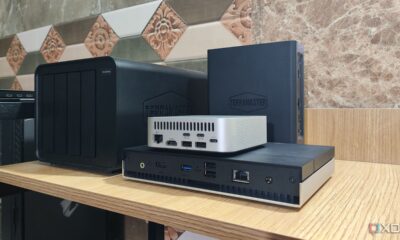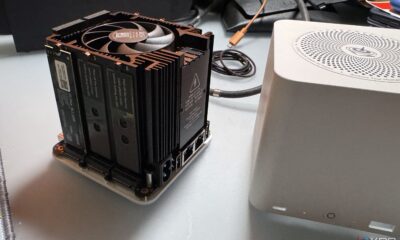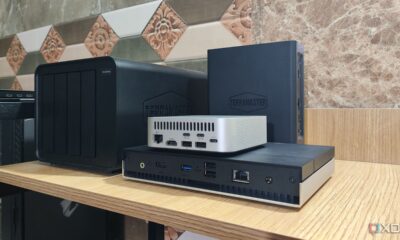Science
Learning from Mistakes: Insights Gained from NAS Failures

Building a Network-Attached Storage (NAS) system can be an enlightening experience, but often the most valuable lessons come from troubleshooting rather than the initial setup. A recent exploration into the world of NAS revealed that the journey is often marked by trial and error, leading to deeper understanding and proficiency.
When I first constructed my NAS using TrueNAS, I dedicated hours to researching both the hardware and operating system aspects. While this preparation was essential, the real education came from diagnosing persistent issues that arose post-setup. Countless errors and misconfigurations provided a crash course in the complexities of network storage systems.
Mastering Network Shares through Experience
Setting up my first NAS involved creating a Samba share with default permissions, which worked adequately at the time. As I delved deeper into network security, I realized the importance of understanding share permissions. Initially, I enabled Guest Access without proper consideration, but I later switched to creating separate user accounts with limited permissions.
Transitioning to TrueNAS Community Edition allowed me to explore advanced features such as Apple Time Shares and Audit Logging. The learning curve was steep, particularly with the SMB Multichannel feature, which requires an understanding of multiple subnets. Yet, the effort paid off with enhanced performance and flexibility.
NFS shares presented additional challenges. My first attempts resulted in frustrating access denied errors, revealing the complex nature of permissions associated with this protocol. Although I prefer SMB for most applications, the hurdles I faced with NFS taught me valuable lessons about mounting commands and user management.
Exploring iSCSI also proved fruitful. After initially avoiding this block-sharing protocol, I found it beneficial for managing virtual machine data. The learning process involved configuring initiators and rectifying misconfigurations, leading to a solid understanding of storage options.
The Importance of Backups and Data Protection
On the storage side, I have always emphasized the significance of backups. Although I did not implement fully automated systems initially, I regularly scheduled backups for my computer during my early days in home labbing. I utilized the snapshot feature on my NAS, mistakenly believing it provided adequate protection. A critical lesson came when I lost an entire dataset due to a failed drive, underscoring the importance of a comprehensive backup strategy.
This setback led me to explore the 3-2-1 backup strategy, which involves maintaining three copies of data on two different media, with one copy stored off-site. My experience prompted me to establish a secondary, budget-friendly server at my parents’ home, ensuring essential files are backed up effectively.
As I ventured further into RAID configurations, I moved beyond a JBOD setup and acquired cost-effective 2TB hard drives. Experimenting with RAID-Z1 revealed both its advantages, such as usable capacity and fault tolerance, and its downsides, particularly slow resilver times after removing a drive. Understanding the differences between RAID levels, including the comparison between RAID-Z1 and RAID 5, was crucial for optimizing my storage solutions.
Another notable benefit of learning about RAID setups was the ability to utilize hot spares for quicker recovery in case of drive failure. I also discovered the better transfer speeds and reliability associated with RAID 1 configurations, which would have been overlooked had I remained with a basic JBOD setup.
In addition to storage strategies, my NAS journey introduced me to self-hosted services. While I had prior experience with virtual machines, containerized environments were unfamiliar territory. Exploring jails in TrueNAS Core generated curiosity, eventually leading to a deeper engagement with Docker environments and Linux Containers (LXCs). This exploration opened new doors in my computing experience, even if it came with a learning curve.
Through this journey of troubleshooting and experimentation, I gained invaluable insights into the operation and management of NAS systems. Each failure and subsequent fix contributed to a richer understanding, highlighting that the path to proficiency is often paved with challenges.
-

 Technology5 months ago
Technology5 months agoDiscover the Top 10 Calorie Counting Apps of 2025
-

 Health2 months ago
Health2 months agoBella Hadid Shares Health Update After Treatment for Lyme Disease
-

 Health3 months ago
Health3 months agoErin Bates Shares Recovery Update Following Sepsis Complications
-

 Technology4 months ago
Technology4 months agoDiscover How to Reverse Image Search Using ChatGPT Effortlessly
-

 Technology1 month ago
Technology1 month agoDiscover 2025’s Top GPUs for Exceptional 4K Gaming Performance
-

 Technology2 months ago
Technology2 months agoElectric Moto Influencer Surronster Arrested in Tijuana
-

 Technology5 months ago
Technology5 months agoMeta Initiates $60B AI Data Center Expansion, Starting in Ohio
-

 Technology5 months ago
Technology5 months agoRecovering a Suspended TikTok Account: A Step-by-Step Guide
-

 Health4 months ago
Health4 months agoTested: Rab Firewall Mountain Jacket Survives Harsh Conditions
-

 Lifestyle5 months ago
Lifestyle5 months agoBelton Family Reunites After Daughter Survives Hill Country Floods
-

 Technology4 months ago
Technology4 months agoHarmonic Launches AI Chatbot App to Transform Mathematical Reasoning
-

 Technology3 months ago
Technology3 months agoUncovering the Top Five Most Challenging Motorcycles to Ride





















